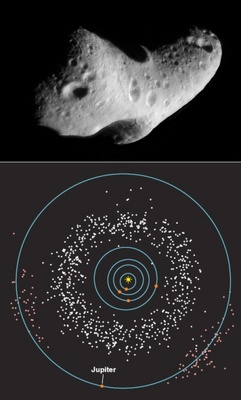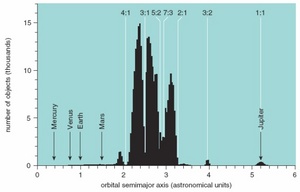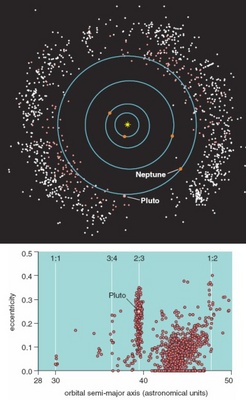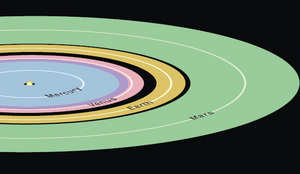Steven Soter is a research associate in the Department of Astrophysics at the American Museum of Natural History in New York City, and scientist-in-residence at New York University, where he teaches on subjects ranging from life in the universe to geology and antiquity in the Mediterranean region. His research interests include planetary astronomy and geoarchaeology. He collaborated with Carl Sagan and Ann Druyan to create the acclaimed Cosmos television series in 1980.
In part one of this two-part essay, Soter explains how computer simulations suggest that planetary systems, including our own, contain as many planets as they can hold without becoming unstable. He says that observations of extrasolar systems should provide the ultimate test of this hypothesis.
Breakdown of the Clockwork Solar System In 1605, Johannes Kepler discovered that the orbits of the planets are ellipses rather than combinations of circles, as astronomers had assumed since antiquity. Isaac Newton was then able to prove that the same force of gravity that pulls apples to the ground also keeps planets in their elliptical orbits around the Sun. But Newton was worried that the accumulated effects of the weak gravitational tugs between neighboring planets would increase their orbital eccentricities (their deviations from circularity) until their paths eventually crossed, leading to collisions and, ultimately, to the destruction of the solar system. He believed that God must intervene, making planetary course corrections from time to time so as to keep the heavens running smoothly.

|
| ©Diagram courtesy of the Minor Planet Center; image courtesy of NASA/Johns Hopkins University Applied Physics Laboratory
|
| The main asteroid belt, situated in a broad region between the orbits of Mars and Jupiter, contains countless rocky bodies (white points in diagram). The Trojan asteroids (pink) can survive outside the belt because they are locked in a 1:1 orbital resonance with Jupiter, which keeps them spaced safely about 60 degrees ahead or behind that giant planet in its orbit. For clarity, only asteroids larger than about 50 km are plotted here. A space probe image of the near-Earth asteroid Eros (above) gives a sense of what most asteroids probably look like. Eros is only about 30 km long, much too small for its gravity to make it spherical.
|
By 1800, the mathematician Pierre-Simon Laplace had concluded that the solar system requires no such guiding hand but is, in fact, naturally self-correcting and stable. He calculated that the gravitational interactions between the planets would forever produce only small oscillations of their orbital eccentricities around their mean values. When asked by his friend Napoleon why he did not mention God in his major work on celestial mechanics, Laplace is said to have replied, "Sir, I had no need for that hypothesis."
Laplace also thought that, given the exact position and momentum of every object in the solar system at any one time, it would be possible to calculate from the laws of motion precisely where everything would be at any future instant, no matter how remote.
Laplace was correct to reject the need for divine intervention to preserve the solar system, but not for the reasons he thought. His calculations of stability were in fact incorrect. In the late 19th century, Henri Poincaré showed that Laplace had simplified some of his equations by removing terms he wrongly assumed to be superfluous, leading him to overlook the possibility of chaos in the solar system. Calculations with modern high-speed computers have finally provided evidence that the solar system is only marginally stable and that its detailed behavior is fundamentally unpredictable over long time periods.
Here I will outline some of the discoveries that led to current ideas about instability in the evolution of the solar system. Now is an especially promising time to consider the subject. Theorists are using powerful computer simulations to explore the formation of planetary systems under a wide range of starting conditions, while observers are rapidly discovering planetary systems around many other stars. The evidence suggests that such systems may be filled nearly to capacity. The abundance of observational data from the newly found planetary systems will stimulate and test our ideas about the delicate balance between order and chaos among the worlds.
Gaps in Understanding In 1866, the American astronomer Daniel Kirkwood produced the first real evidence for instability in the solar system in his studies of the asteroid belt, which lies between the orbits of Mars and Jupiter. At the time, only about 90 asteroids were known (the orbits of more than 150,000 have since been charted), but that meager population was sufficient for Kirkwood to notice several "gaps" in the distribution of their orbital periods or, equivalently, in their orbital sizes. (The orbital periods of planets, asteroids and comets increase with orbital size in a well-defined way.) Kirkwood found that no asteroid had a period near 3.9 years, which, he noted, is one-third that of Jupiter.
An asteroid that orbits the Sun exactly three times while Jupiter goes around just once would make every close approach to the giant planet at the same point in its own orbit and get a similar gravitational kick from its massive celestial neighbor each time. The repeated tugs Jupiter exerted would tend to add up, or resonate, from one passage to the next. Hence astronomers would refer to such an asteroid as being in a 3:1 mean-motion resonance. Other gaps in the asteroid belt correspond, for example, to where the orbital period of Jupiter would have a ratio of 5:2 or 7:3 to that of an asteroid.

|
| ©Minor Planet Center
|
| Resonant effects can be clearly seen in the radial distribution of the asteroids. Some orbital resonances are destabilizing, creating minima in the distribution, called "Kirkwood gaps"; after Daniel Kirkwood, the astronomer who first recognized them. The main asteroid belt is bounded by the 4:1 and 2:1 resonances with Jupiter. The stable 3:2 and 1:1 resonances account, respectively, for the Hilda family asteroids and Jupiter Trojans. One astronomical unit is the Earth-Sun distance.
|
A simple way to understand resonance is to push someone on a swing. If you push at random phases in the swing's motion, not much happens. But if you push each time the swing returns to you, the forces add up and the swing goes higher and higher. You could also push at the same phase but less frequently, say only every 2 or 3 swing periods; the swing would then take longer to reach a given height, because such resonances are weaker.
An asteroid in such a resonant orbit can have its eccentricity increased until the body either collides with the Sun or a planet, or encounters a planet closely enough to be tossed into another part of the solar system. Asteroids that had been orbiting stably in the main belt are sometimes nudged into one of the resonant Kirkwood gaps, from which Jupiter eventually ejects them. These gaps are like holes through which the asteroid population is slowly draining away. Many of the meteorites that strike Earth are fragments that were ejected from the asteroid belt after straying into one of the resonant gaps.
Something similar takes place in the outer solar system. Gravitational tugs from the giant planets gradually remove icy worlds from the Kuiper belt, which lies beyond the orbit of Neptune. This process supplies the short-period comets, which enter the inner solar system for a brief time and return to it at regular intervals. In the early solar system, close encounters of small icy bodies with the growing giant planets populated the distant Oort cloud with hundreds of billions of cometary nuclei.
Such interactions also caused the orbits of the major planets to migrate. Because the growing planets Saturn, Uranus and Neptune tossed more small bodies inward toward the orbit of Jupiter than out of the solar system, those planets migrated outward, to conserve the total angular momentum. But the much more massive planet Jupiter ejected most of the small bodies it encountered into the outer solar system and beyond, and it consequently migrated inward. When the solar system was forming, the Kuiper belt contained hundreds of times more mass than it does today. The objects now in the belt represent only the small fraction that managed to survive. The same is true of the asteroid belt. Gravitational sculpting by the planets has severely depleted both populations, leaving the Kuiper and asteroids belt remnants of the primordial planetesimal disk.
Whereas some mean-motion resonant orbits in the solar system are highly unstable, others are quite resistant to disruption. (The difference depends on subtle details of the configuration of the interacting bodies.) Many of the objects in the Kuiper Belt have their orbits locked in a stable 2:3 mean-motion resonance with Neptune. They orbit the Sun twice for every three orbits of this planet. Such objects are called plutinos, after Pluto, the first one discovered. Some of them, including Pluto, cross inside the orbit of Neptune, but the geometry of their resonant orbits keeps them from making close approaches to the planet and accounts for their survival.
Thousands of small worlds called Trojan asteroids share Jupiter's orbit around the Sun, leading or following the planet by about 60 degrees. These bodies are trapped in a so-called 1:1 mean-motion resonance, the planet and asteroid having the same orbital period. This configuration inhibits close approaches to Jupiter and is relatively stable. Similar families of co-orbital asteroids accompany both Neptune and Mars around the Sun.
Gravitational tugs of the planets on one another produce cyclical motions in the spatial orientation of their orbits, causing another kind of resonance. The rotation of the orientation of an elliptical orbit takes many times longer than the orbital period of the planet itself. These slow gyrations of an entire orbit produce so-called secular resonances, which can strongly distort the orbits of smaller bodies - and not just those in the asteroid belt. The solar system is crowded with potential orbits on which objects would be subjected to secular or mean-motion resonances. Many resonant orbits overlap, and wherever that happens, small orbiting bodies are especially prone to chaotic behavior, which is fundamentally unpredictable.

|
| ©Minor Planet Center
|
| Stable resonances are evident in the distribution of small bodies in the outer solar system (above). The Neptune Trojans, objects in a 1:1 resonance with that planet, orbit at 30 astronomical units from the Sun. Reaching farther out are the Kuiper-belt objects, including Pluto and its fellow "plutinos" (which share a stabilizing 2:3 resonance with Neptune), and objects locked into 3:4 and 1:2 resonances. Most of the plutinos (pink objects at left) and other Kuiper-belt objects (white) are located outside the orbit of Neptune. For clarity, transient comets and scattered Kuiper-belt objects are not shown.
|
Despite its orderly appearance, the solar system actually includes many elements of what mathematicians call chaos. A defining feature of chaos is the extreme sensitivity of a system to its initial conditions. The most trivial disturbance in such a system can profoundly change its large-scale configuration at a later time. A pool table provides a familiar example: Microscopic variations in the trajectory of a billiard ball, especially one involved in multiple collisions, can completely alter the outcome of the game. Chaotic systems are deterministic, in that they follow precisely the laws of classical physics, but they are fundamentally unpredictable. The nature of chaos was not well understood until recently, when increasing computer power allowed mathematicians to explore it in sufficient detail. No one in Laplace's day imagined that the solar system, then taken as the paradigm of clockwork stability, is actually vulnerable to chaos.
Cleaning Up the Solar SystemJacques Laskar, of the Bureau des longitudes in Paris, has carried out the most extensive calculations to investigate the long-term stability of the solar system. He simulated the gravitational interactions between all eight planets over a period of 25 billion years (five times the age of the solar system). Laskar found that the eccentricities and other elements of the orbits undergo chaotic excursions, which make it impossible to predict the locations of the planets after a hundred million years. Does Laskar's result mean that the Earth might eventually find itself in a highly elliptical orbit, taking it much closer to and farther from the Sun, or that the solar system could lose a planet?
No. Even chaos has to operate within physical limits. For example, although meteorologists cannot predict the weather (another chaotic system) as far as a month in advance, they can be quite confident that conditions will fall within a certain range, because external constraints (such as the Sun's brightness and the length of the day) set limits on the overall system.
Laskar found that, despite the influence of chaos on the exact locations of the planets, their orbits remain relatively stable for billions of years. That is, whereas the long-term configuration is absolutely unpredictable in detail, the orbits remain sufficiently well behaved to prevent collisions between neighboring planets. An external constraint in this case is imposed by the conservation of angular momentum in the system, which limits the excursions of orbital eccentricity for bodies of planetary mass.
The orbits of the massive outer planets are the most stable. The smaller terrestrial planets, particularly Mars and Mercury, are more vigorously tossed about. The simulations show that over millions of years the terrestrial planets undergo substantial excursions in their eccentricities - large enough for those planets to clear out any debris from the intervening orbital space, but not large enough to allow collisions between them. However, Laskar found one possible exception: Mercury, the lightest planet, has a small but finite chance of colliding with Venus on a timescale of billions of years. He concluded that the solar system is "marginally stable."

|
| ©n/a
|
| Numerical simulations conducted by Jacques Laskar revealed that the maximum orbital eccentricity of the inner planets changes considerably over time. Thus over billions years, each planet would cut a broad swath (colored bands) around its mean orbit (white lines). Indeed, Mercury's orbital eccentricity can, in principle, become large enough that it risks collision with Venus. Although the orbits of other terrestrial planets will never cross in this way, they largely fill the inner solar system when one considers their long-term variations. (Adapted from Laskar 1996.)
|
Such results suggested to Laskar that the solar system is dynamically "full" or very nearly so. That is, if you tried to squeeze another planet in between the existing ones, the resulting gravitational disturbances would dynamically excite the system, leading to a collision or ejection before the system could settle down again.
Laskar surmised that the solar system, at each stage of its evolution, was always near the edge of instability, as it appears to be today. To maintain its marginal stability, the solar system has been eliminating objects on a timescale comparable with its age at every epoch. It follows that the solar system billions of years ago may have contained more planets that it does now.
According to this view, as the solar system matured, it managed to remain stable against the breakout of large-scale chaos by reducing the number of planets and increasing the spacing between them. The present number must be about as large (and their spacing about as small) as allowed by the system's long-term stability. The solar system has increased its internal order by exporting disorder - entropy - to the rest of the Galaxy, which receives the chaotically ejected objects.
This process, called dynamical relaxation, operates in star clusters and in entire galaxies as well as in evolving planetary systems. As such systems expel their most unstable members, the orbits of the remaining objects become more compact and well organized.
Extensive computer simulations show that the eight planets greatly disturb the motions of test particles placed on circular orbits at most locations in the solar system. Such particles are sent into close encounters with the planets, which remove them in only a few million years, a small fraction of the age of the solar system. But these simulations also identify several regions where objects can survive for far longer times. One such region is a broad zone centered about halfway between the orbits of Mars and Jupiter - the asteroid belt. Computer simulations by Jack Lissauer and colleagues at NASA Ames Research Center and at Queen's University, Ontario, showed that if an Earth-sized planet had formed there, it could remain in a stable orbit for billions of years. This result is not too surprising, because the zone of the asteroid belt is well-populated and must therefore be relatively immune to disturbance. The same study found however that a giant planet in the asteroid belt would soon become unstable.
The Kuiper belt is another region of stability, as there are no more planets to stir up the neighborhood beyond the orbit of Neptune. The Trojan asteroids of Mars, Jupiter and Neptune occupy other protected interplanetary niches.
Aside from such islands of stability, interplanetary space is remarkably empty. Most of the small objects orbiting between the planets (such as Earth-crossing asteroids and short-period comets) are transient interlopers, which recently leaked into the neighborhood from the asteroid and Kuiper belts. The planets will soon eject them or sweep them up in collisions. Indeed, a planet is now defined by the requirement that the object has cleared its orbital neighborhood of other material. Were it not for the leaky reservoirs that supply a steady trickle of debris to their vicinity, the planets would have thoroughly cleaned out most of the orbital space between them.
This essay continues next week.
Reader Comments